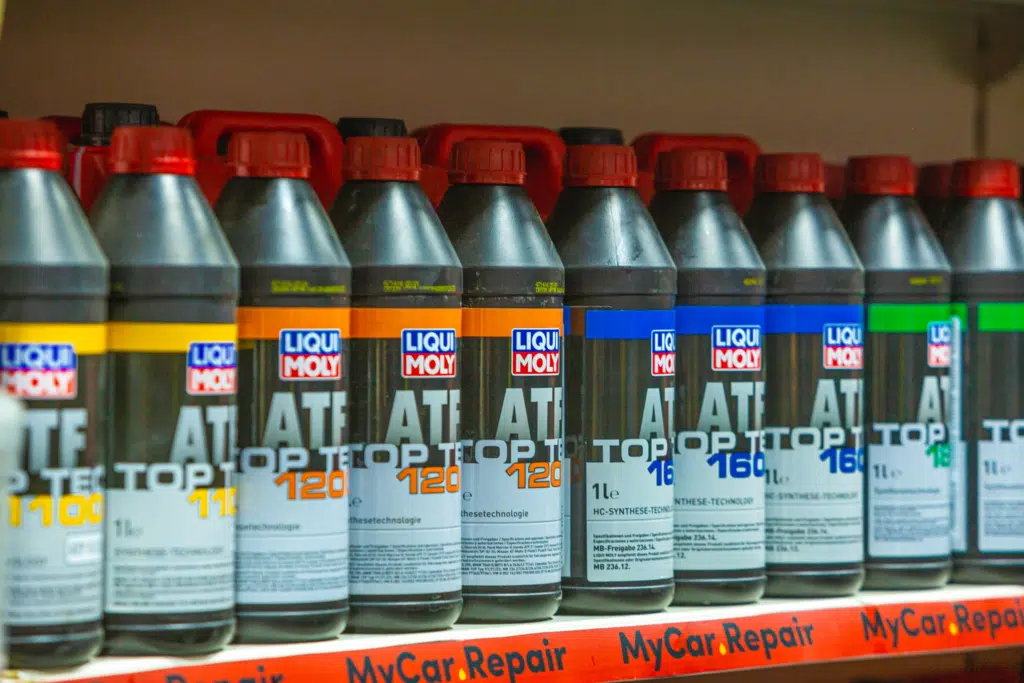Did you know that your vehicle’s transmission fluid automatic (ATF) plays a crucial role in ensuring smooth and efficient performance? This essential fluid is often overlooked, but it can make a world of difference in the lifespan and functionality of your transmission. In this comprehensive guide, we’ll explore the fascinating world of ATF, its different types, how to choose the right one for your vehicle, and maintenance tips to keep your transmission in perfect condition. So buckle up and let’s dive in!
Key Takeaways
Understanding Automatic Transmission Fluid and its role in modern automatic transmissions is essential for optimal performance.
Regular maintenance such as fluid exchanges, flushes and filter replacements helps to prevent issues with the transmission.
Selecting an ATF compatible with manufacturer specifications is key for ensuring proper functioning of the vehicle’s automatic transmission.
Understanding Automatic Transmission Fluid
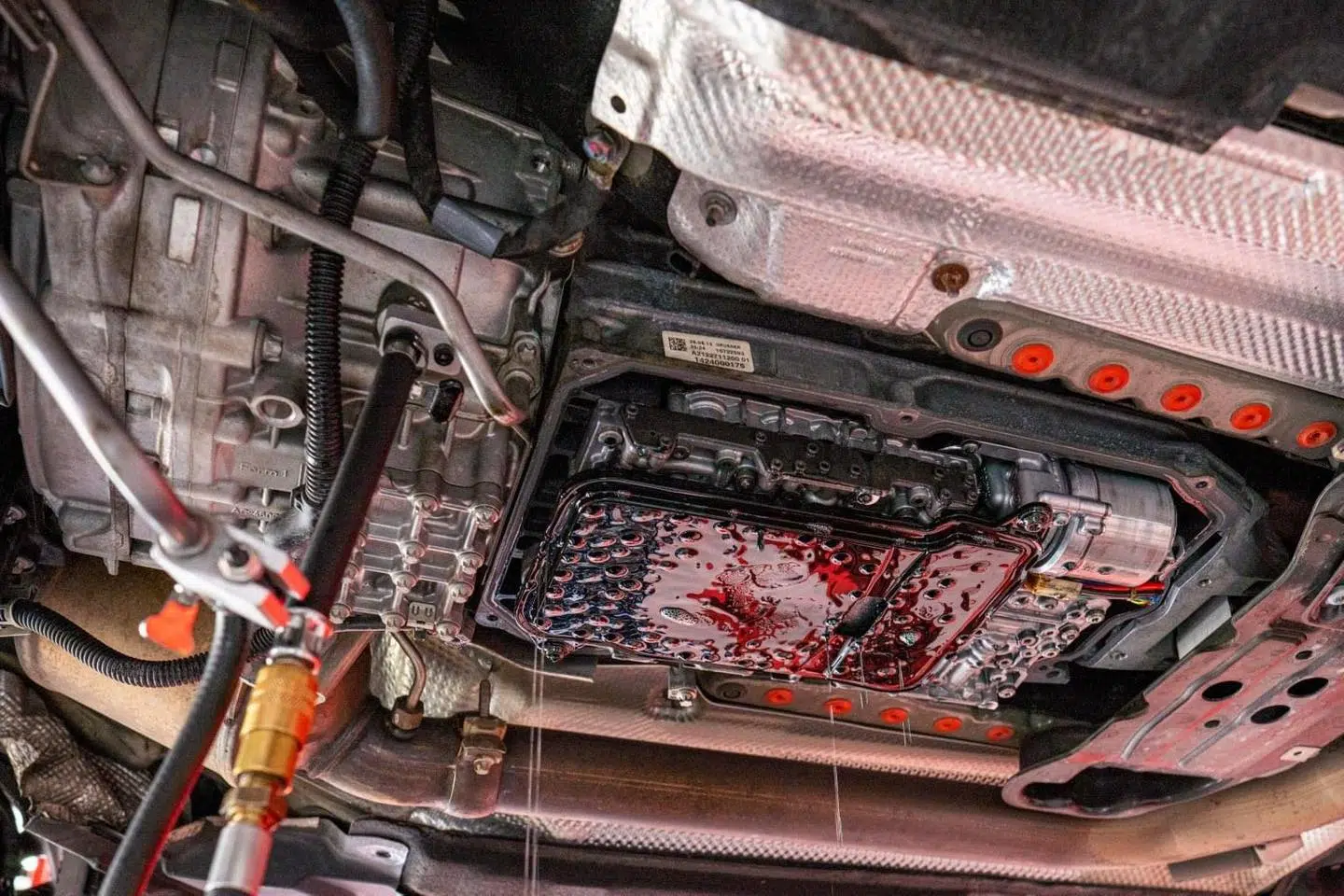
Automatic Transmission Fluid (ATF) is a hydraulic fluid designed specifically for modern automatic transmissions, such as GM automatic transmissions and automatic gearboxes, which transmit power from the engine to the driveshaft without manual gear shifting. The development of ATF is closely associated with the evolution of automatic transmission technology, ensuring that the fluid meets the special requirements of these sophisticated systems, including the use of various automatic transmission fluids.
We will delve into the critical function of ATF in automatic transmissions, examine the various types of ATF, and introduce the LIQUI MOLY ATF product range.
The Role of ATF in Automatic Transmissions
ATF serves multiple purposes within an automatic transmission, including lubricating, cooling, and providing hydraulic pressure. This versatile fluid is essential for optimal transmission performance and component life, especially under extreme pressure conditions.

Exchanging the automatic transmission fluid every three years or 30,000 miles is advisable for maintaining optimum performance and avoiding transmission issues. Additionally, a gearbox flush can help prevent potential issues that could lead to costly repairs or transmission replacement.
Types of ATF
There are two primary types of ATF: synthetic and conventional fluids. Synthetic ATF is a modern lubricant option that offers improved performance and extended service life for certain applications, such as frequent trailer towing. Synthetic ATF provides increased resistance to heat, cold, oxidation, and sheer.
Conventional fluids, on the other hand, are a more traditional option for less demanding applications. Some transmissions also require specialized fluids for optimal performance, such as those found in continuously variable transmissions (CVTs) and dual-clutch transmissions, or even specific types like mercon fluids.
Choosing the right ATF for your vehicle, aligned with the manufacturer and common ATF specifications, is crucial in optimizing performance and extending your transmission’s lifespan.
LIQUI MOLY ATF Product Range and its approvals
LIQUI MOLY offers a selection of ATF products that are compliant with various vehicle manufacturers’ specifications. This means that you can trust LIQUI MOLY’s ATF products to meet the unique requirements of your vehicle’s transmission, ensuring smooth performance and a long-lasting transmission.

Regularly changing your ATF, as recommended by the manufacturer, can help prevent or address common automatic transmission issues. It’s essential to follow the manufacturer’s recommended service intervals for ATF replacement to ensure the longevity and performance of your transmission.
LIQUI MOLY ATF 1100
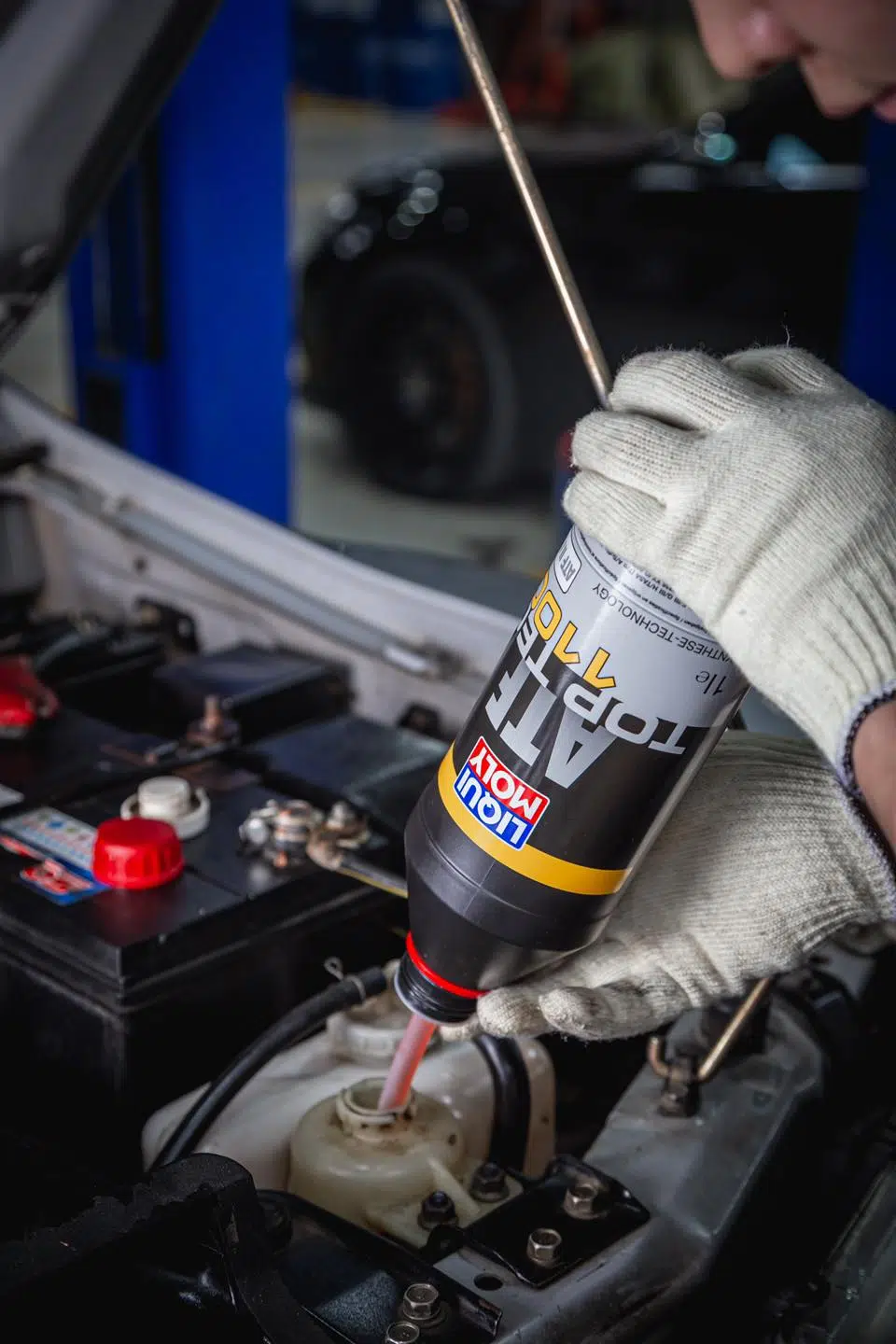
Approvals: Allison C4, Dexron III G/III H/TASA (Typ A/Suffix A), DTFR 13C100 (236.1), Ford Mercon, MAN 339 Typ L1/339 Typ V1/339 Typ Z1, MB-Freigabe 236.1, Voith H55.6335.XX (G 607), ZF TE-ML 03D/04D/14A/17C, ZF Freigabenummer ZF004926
Recommendations: Allison TES 389, Caterpillar TO-2, Ford ESP-M2C 166-H, MB 236.6, Volvo 97341, ZF TE-ML 02F, ZF TE-ML 09, ZF TE-ML 11A, ZF TE-ML 11B, ZF TE-ML 14B
LIQUI MOLY ATF 1200
Approvals: Allison C4, Dexron III H, Ford Mercon V, Honda ATF Z1 (except CVT), Hyundai SP-II, Hyundai SP-III, JASO 1-A, Kia SP-II, Kia SP-III, Mazda ATF M-III, Mazda ATF M-V, Mitsubishi SP-II, Mitsubishi SP-III, Nissan AT-Matic D Fluid, Nissan AT-Matic J Fluid, Nissan AT-Matic K Fluid, Toyota Type T-II, Toyota Type T-IV
Recommendations: Allison TES 295, BMW 7045 E, BMW 8072 B, BMW LA 2634, BMW LT 71141, Caterpillar TO-2, Chrysler ATF +3, Chrysler ATF +4, Daimler NAG-1, JWS 3309 (Aisin Warner), MAN 339 Typ V1, MAN 339 Typ Z1, MAN 339 Typ Z2, MB 236.10, MB 236.11, MB 236.2, MB 236.5, MB 236.6, MB 236.7, MB 236.9, MB 236.91, Subaru ATF, Voith H55.6335.XX (G 607), Volvo 97340, Volvo 97341, VW G 052 162, VW G 052 990, VW G 055 025, ZF TE-ML 02F, ZF TE-ML 03D, ZF TE-ML 04D, ZF TE-ML 05L, ZF TE-ML 09, ZF TE-ML 11A, ZF TE-ML 11B, ZF TE-ML 14A, ZF TE-ML 14B, ZF TE-ML 17C
LIQUI MOLY ATF 1400

Recommendations: Dodge CVTF+4, Dodge NS-2, Ford CVT23, Ford CVT30, Ford Mercon C, GM/Saturn DEX-CVT, Honda HCF2, Honda HMMF, Hyundai SP-CVT 1, Jeep CVTF+4, Jeep NS-2, Kia SP-CVT 1, MB 236.20, Mini Cooper (EZL 799), Mitsubishi CVTF-J1, Mitsubishi CVTF-J4, Nissan CVT NS-2 Fluid, Nissan NS-3 CVT Fluid, Subaru E-CVT, Subaru High Torque CVTF, Subaru Lineartronic CV-30, Subaru Lineartronic CVTF, Subaru Lineartronic CVTF II, Subaru NS-2, Suzuki CVT Green1, Suzuki CVT Green2, Suzuki NS-2, Suzuki TC, Toyota CVTF FE, Toyota TC, VW G 052 180, VW G 052 516
LIQUI MOLY ATF 1600

Approvals: MB-Approval 236.14
Recommendations: MB 236.12
LIQUI MOLY ATF 1800
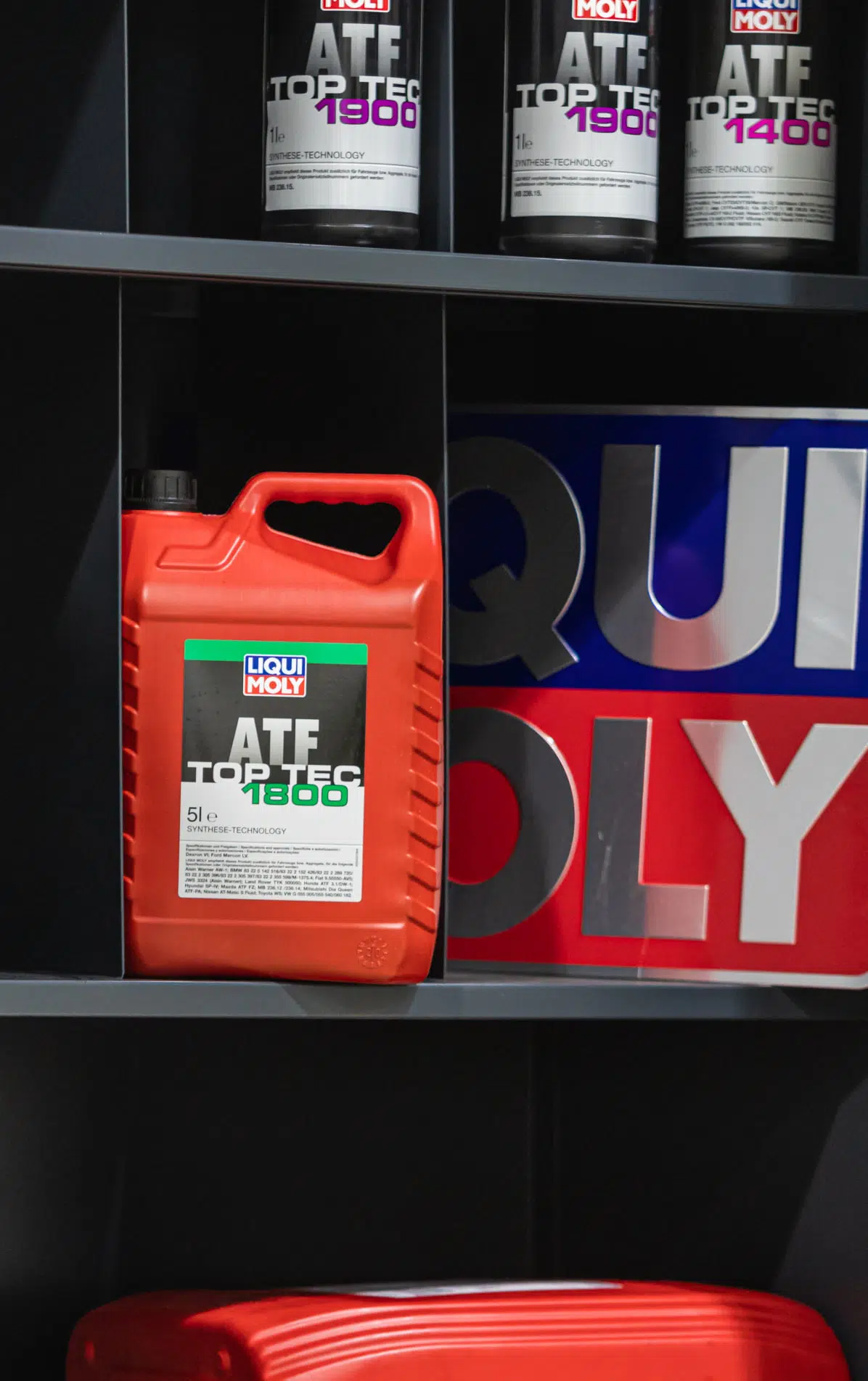
Approvals: Dexron VI, Ford Mercon LV
Recommendations: Aisin Warner AW-1, BMW 83 22 0 142 516, BMW 83 22 2 152 426, BMW 83 22 2 289 720, BMW 83 22 2 305 396, BMW 83 22 2 305 397, BMW 83 22 2 355 599, BMW M-1375.4, Fiat 9.55550-AV5, Honda ATF 3.1, Honda ATF DW-1, Hyundai SP-IV, Hyundai SP-IV-RR, Isuzu ATF WSI, JASO 1A-LV, JWS 3324 (Aisin Warner), Land Rover TYK 500050, Mazda ATF FZ, MB 236.12, MB 236.14, Mitsubishi Dia Queen ATF-MA1, Mitsubishi Dia Queen ATF-PA, Nissan AT-Matic S Fluid, Nissan Matic P, Toyota WS, VW G 055 005, VW G 055 162, VW G 055 540, VW G 060 162
LIQUI MOLY ATF 1900
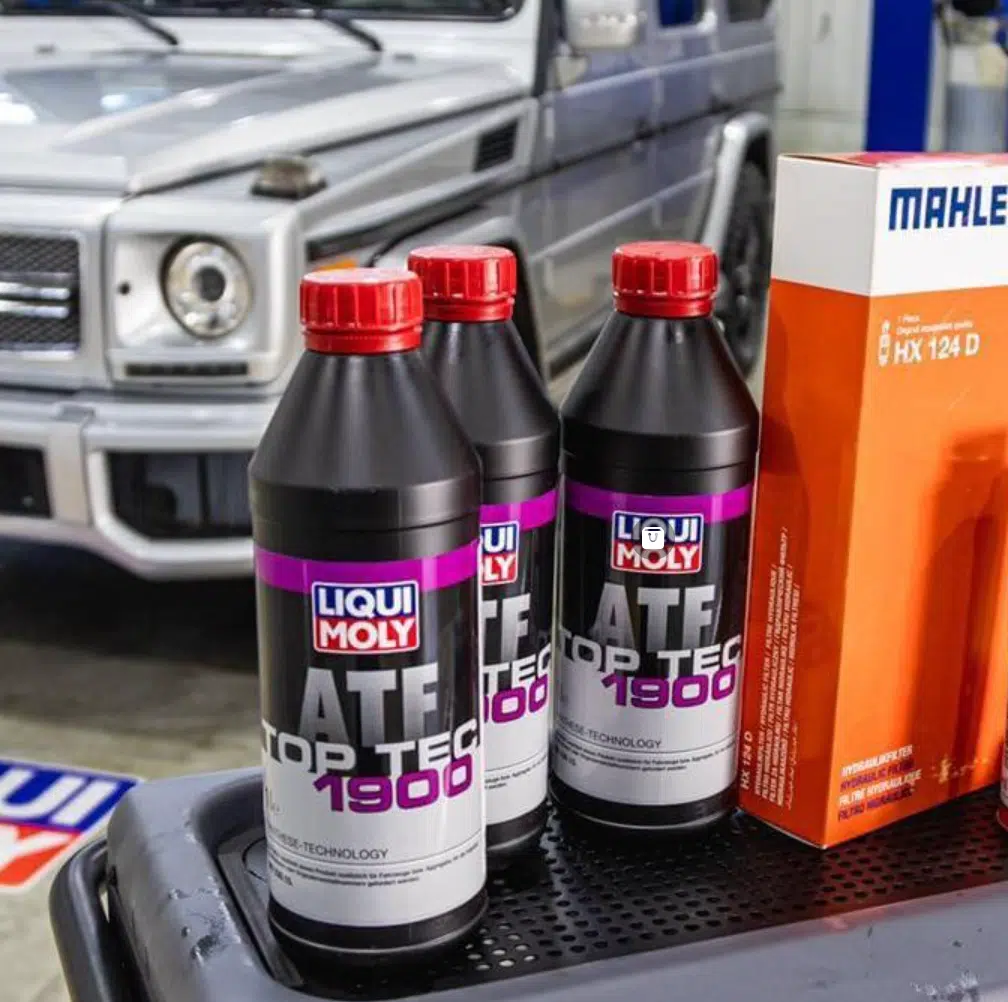
Recommendations: MB 236.15
LIQUI MOLY ATF 1950
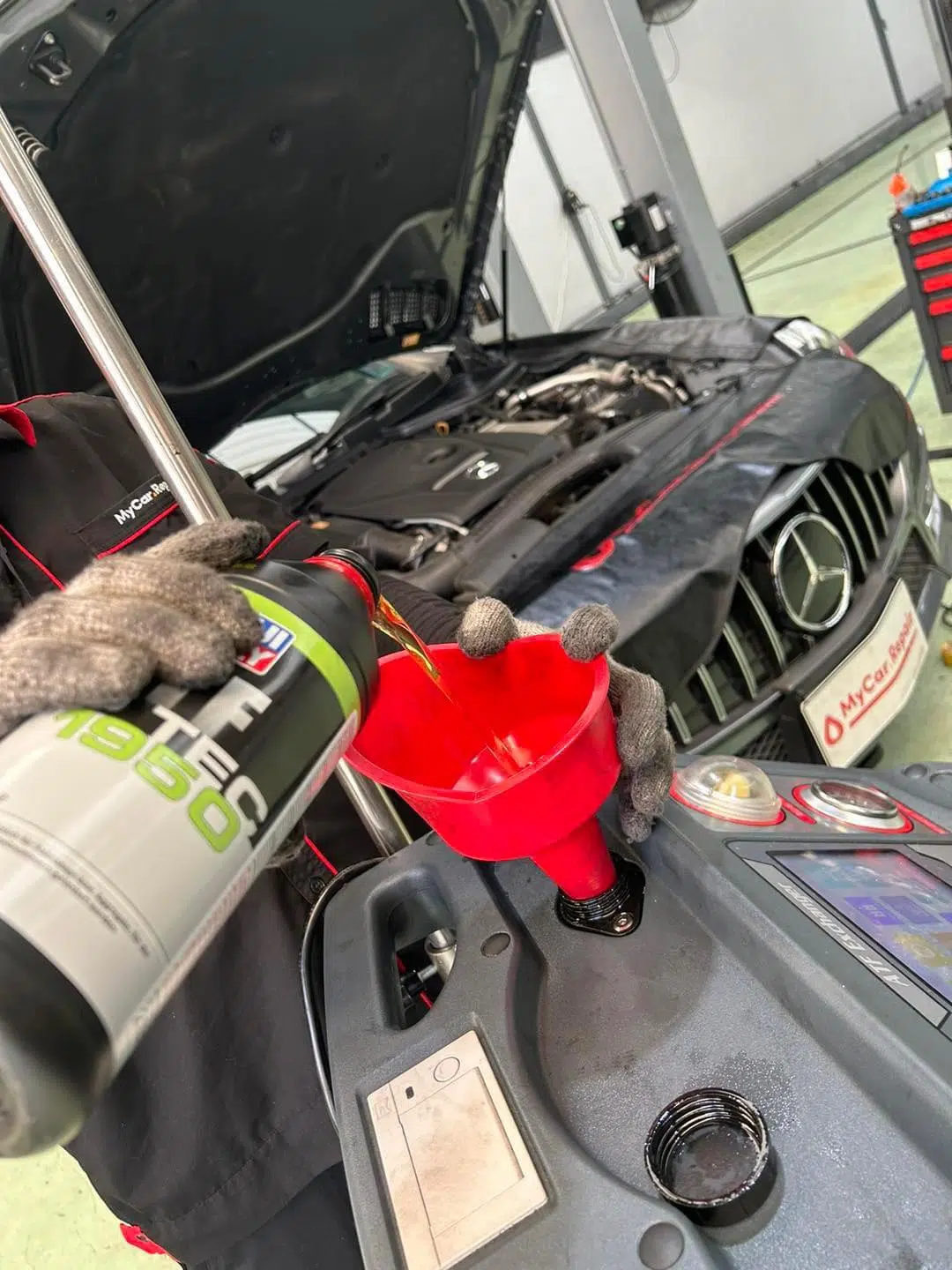
Recommendations: MB 236.17
LIQUI MOLY Dual Clutch Transmission Oil 8100
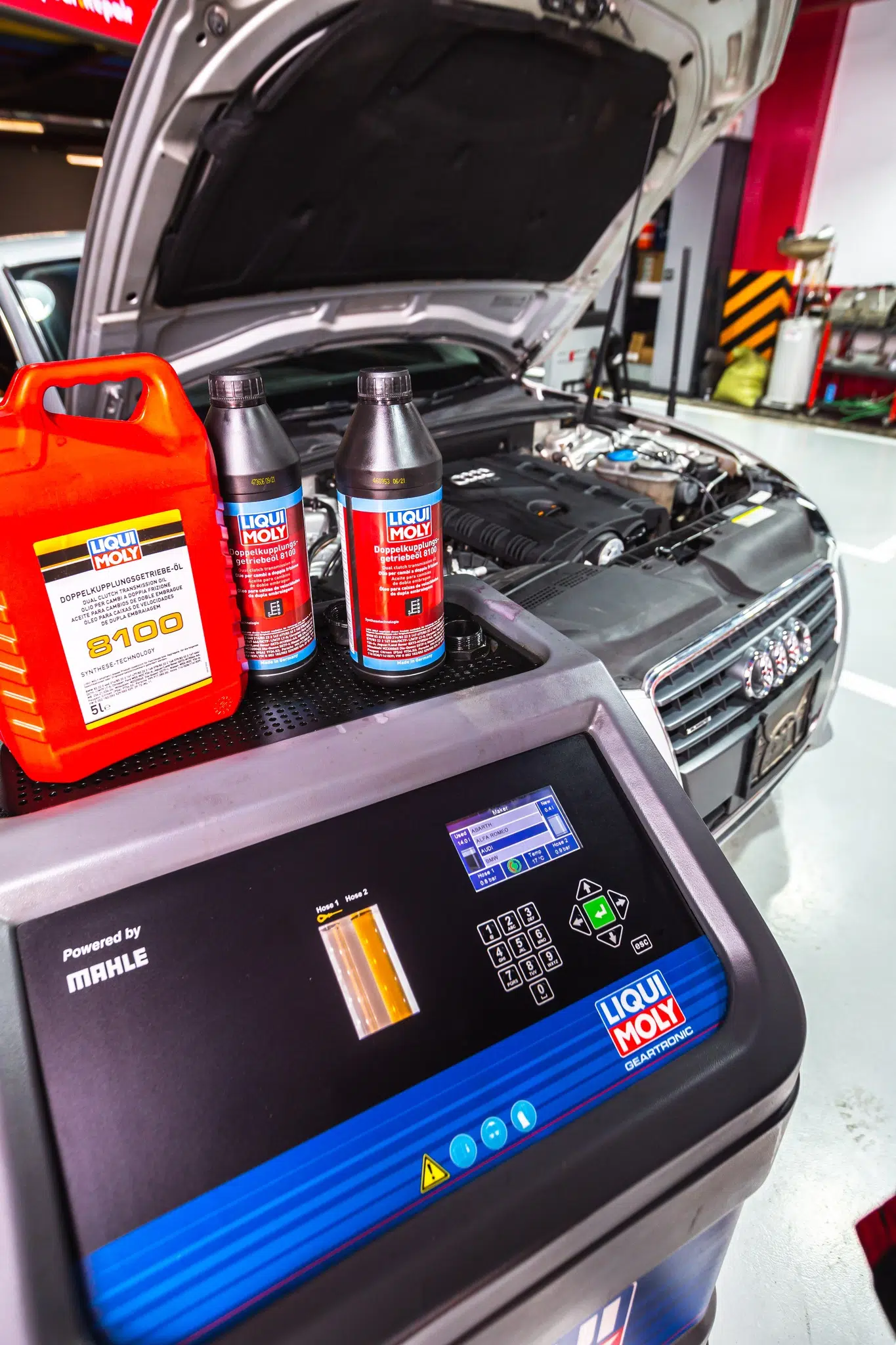
Recommendations: BMW 83 22 0 440 214, BMW 83 22 2 147 477, BMW 83 22 2 148 578, BMW 83 22 2 148 579, BMW 83 22 2 167 666, BMW 83 22 2 433 157, BMW DCTF-1, BMW DCTF-1+, BMW DCTF-2, BMW MTF LT-5, Chrysler, Chrysler 68044345 EA, Chrysler 68044345 GA, Eaton PS-278, Fiat 9.55550-HE2, Fiat 9.55550-MZ6, Ford 1490761, Ford 1490763, Ford F-DC, Ford KU7JM2C218AA, Ford WSS-M2C 218-A, Ford WSS-M2C 936-A, Jaguar / Land Rover GX73-M1R564-AA, MB 236.21, MB 236.24, MB 239.21, MB A 000 989 04 03, MB A 000 989 20 02, Mitsubishi MZ320065 Dia-Queen SSTF-I, Peugeot Citroen (PSA) 9734.S2, Porsche 999.917.080.00, Porsche 999.917.080.01, Renault DW5, Renault DW6, Volvo 1161838, Volvo 1161839, VW G 052 182, VW G 052 529, VW G 052 536, VW G 055 529, VW G 055 536, ZF TE-ML 11
Selecting the Right ATF for Your Vehicle

Choosing the right ATF for your vehicle is crucial for optimal performance and longevity of your automatic transmission. The best ATF for your vehicle depends on the specific requirements of your vehicle’s transmission, which can be found in your owner’s manual or by consulting a qualified mechanic.
We will further discuss the significance of selecting the appropriate ATF in accordance with manufacturer specifications and common ATF specifications.
Manufacturer Specifications
Selecting the right ATF, based on the manufacturer’s recommendations usually found in your vehicle’s owner’s manual, is crucial. Adhering to these specifications ensures that the fluid being installed into your transmission is suitable for your vehicle’s specific requirements.
Remember, using the incorrect fluid can cause damage to your transmission and result in costly repairs. Always consult your vehicle manufacturer’s guidelines when selecting the appropriate ATF for your vehicle.
Common ATF Specifications
Aside from manufacturer specifications, there are common ATF specifications that are widely utilized in the automotive industry, such as the General Motors (GM) DEXRON and Ford MERCON series. These specifications are designed to meet the unique requirements of various transmissions, ensuring optimal performance and longevity.
Opting for an ATF that complies with both the manufacturer and common specifications will ensure that your vehicle’s transmission gets the needed care and maintenance for optimal functioning.
Signs Your Automatic Transmission Needs Fluid Replacement
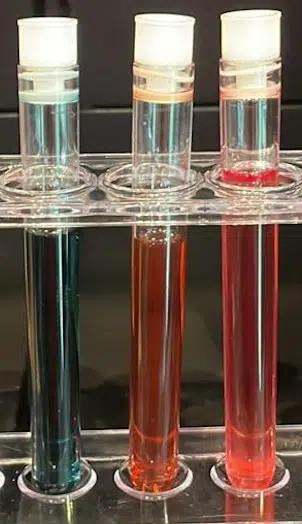
Just like engine oil, ATF can degrade over time and lose its effectiveness, which can lead to transmission problems. It’s essential to recognize the signs that your automatic transmission may need a fluid replacement, such as shifting problems and overheating, to prevent costly repairs or even transmission failure.
We will analyse the symptoms of these issues and how they can suggest the need for ATF replacement.
Shifting Problems
Shifting problems can be a telltale sign that your ATF needs replacing. Symptoms may include delayed engagement, slipping gears, and rough shifting. These issues can be caused by restricted flow of oil due to clogged internal filters and slow oil circulation.
Regularly assessing the color and odor of your ATF can help you identify potential issues. If the fluid appears dark brown or black or has a burnt smell, it may be time for a change.
Transmission Overheating
Another sign that your automatic transmission may need a fluid replacement is overheating. Indications of transmission overheating may include the presence of burning smells and smoke.
ATF plays a vital role in preventing transmission overheating by lubricating and cooling the transmission. Regularly checking your ATF levels and replacing it when necessary can help prevent costly damage to your transmission.
How to Change Automatic Transmission Fluid – Flushing Method

After discussing the significance of ATF and the indications for its replacement, we will now explain how to change your automatic transmission fluid using the flushing method. This method involves draining the old fluid, flushing the system to remove contaminants and old fluid, and refilling with new fluid.
We will walk you through this process in a step-by-step manner.
Draining Old Fluid
The first step in changing your automatic transmission fluid is to drain the old fluid. To do this, follow these steps:
Locate the drain plug, usually situated at the lower part of the transmission.
Position a drain pan underneath the transmission to catch the old fluid.
Use a wrench to remove the drain plug or bolt.
Once the old fluid is drained, clean the transmission fluid pan to remove any sediment.
Flushing the System
After draining the old fluid, the next step is to flush the transmission system. This process involves removing contaminants and old fluid from the system to ensure optimal performance and prevent damage to the transmission.
To flush the system, follow the manufacturer’s instructions for your specific vehicle, which may involve using a specialized flushing machine or manually flushing the system by adding new fluid and circulating it throughout the transmission.
Refilling with New Fluid
Once the system has been flushed, it’s time to refill your transmission with new ATF. To do this, follow these steps:
Locate the transmission fluid dipstick and remove it.
Insert a funnel into the dipstick tube.
Slowly pour the new transmission fluid into the funnel, checking the fluid level frequently to avoid overfilling.

Be sure to use the correct type of transmission fluid, as recommended by your vehicle manufacturer, to ensure optimal performance and longevity of your transmission.
How to Change Automatic Transmission Fluid – Using Automatic Transmission Cleaner Additive Method

An alternative method for changing your automatic transmission fluid involves using an automatic transmission cleaner additive. This method can help improve shifting performance and extend the life of your transmission by cleaning deposits, sludge, and varnish from the internal components.
We will walk you through this process in a step-by-step manner.
Adding Automatic Transmission Cleaner to old ATF Fluid

Begin by preparing your vehicle for the process. Here are the steps to follow.
Allow your car to idle for a few minutes to bring the transmission fluid to operating temperature.
Turn off the ignition.
Raise the vehicle if needed for better access to the transmission.
Add the automatic transmission cleaner to the existing ATF according to the product instructions. Start the engine and allow it to run for several minutes, shifting through all gears, to circulate the cleaner through the transmission.
Circulating the cleaning fluid and ATF in the System
With the cleaner added to the old ATF, the next step is to circulate the cleaning fluid and ATF in the system. Run the engine for about 10-15 minutes, shifting through all gears, allowing the cleaning fluid and old ATF to mix and remove any contaminants.
This circulation process will help clean the internal components of your transmission, improving performance and extending its life.
Draining the old ATF
After circulating the cleaning fluid and old ATF, the next step is to drain the old fluid. Here’s how:
Locate the transmission fluid pan.
Place a large bucket beneath the pan to catch the old fluid.
Remove the drain plug or bolt using a wrench or socket.
Allow the old fluid to drain into the bucket.
Be sure to properly dispose of the used fluid according to local regulations.
Refilling with New Fluid
Finally, refill your transmission with new ATF. Here’s how:
Park your car on a level surface with the engine running.
Locate the transmission fluid dipstick.
Remove the dipstick and insert a small funnel into the dipstick tube.
Slowly pour the new transmission fluid into the funnel, checking the fluid level regularly to avoid overfilling.

Be sure to use the correct type of transmission fluid, as recommended by your vehicle manufacturer, for optimal performance and longevity.
Automatic Transmission Fluid Maintenance Tips
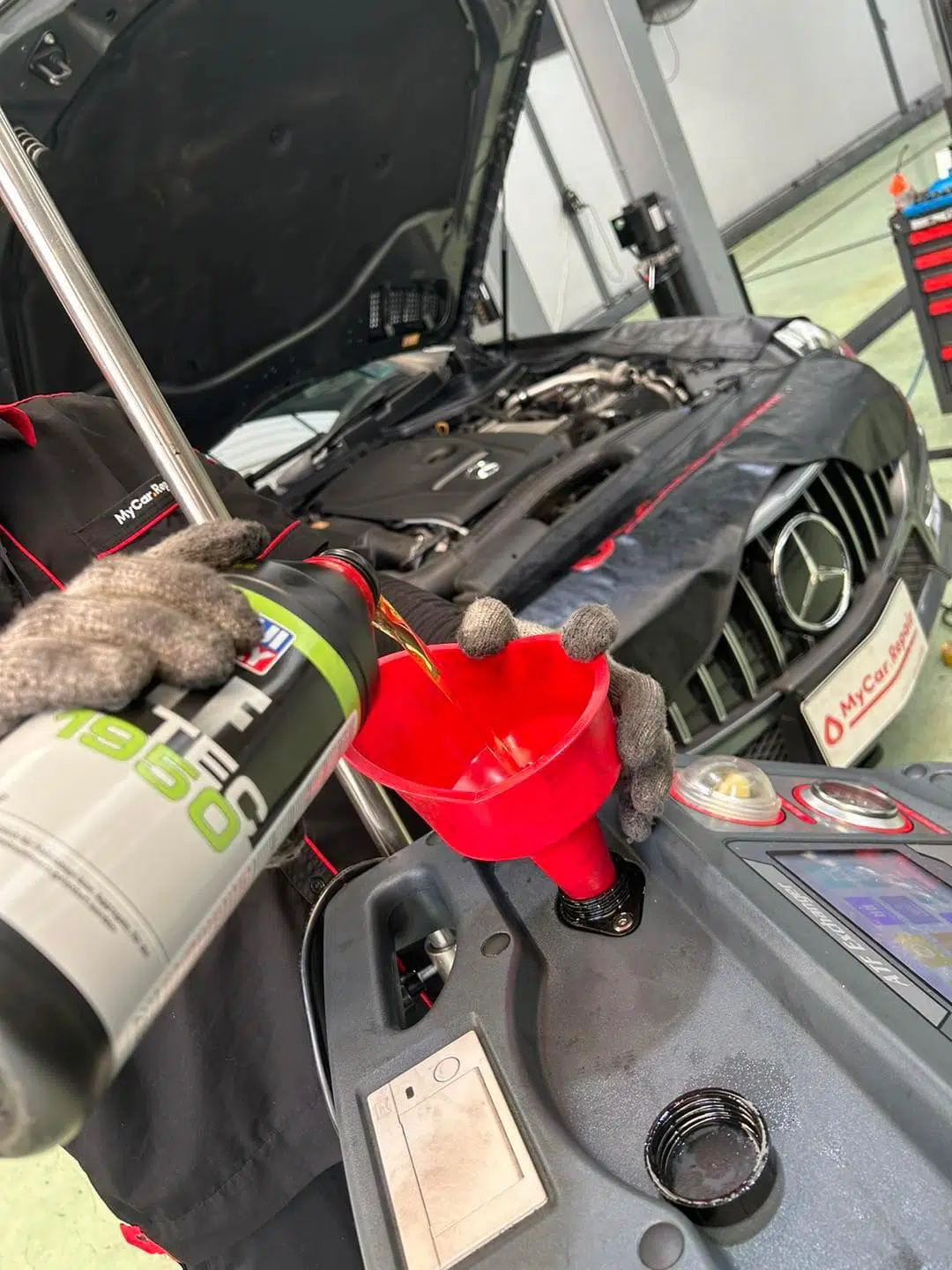
Proper maintenance and care of your automatic transmission fluid can significantly extend the life of your transmission and improve its performance.
We will provide some vital tips for ATF maintenance, which include checking fluid levels, adhering to recommended service intervals, and timely replacement of oil filters.
Checking Fluid Levels and Condition
Regularly checking your ATF levels and condition is an easy way to ensure your transmission is operating at its best. To check the fluid level, follow these steps:
Locate and remove the transmission fluid dipstick.
Wipe it clean with a cloth.
Reinsert the dipstick.
Remove it again to check the fluid level.
When assessing the color, odor, and viscosity of the fluid, also check the condition of the brake discs, noting any darkening, burnt smells, or changes in viscosity that may indicate a need for replacement. If you notice any debris or contamination in the fluid, it should also be replaced.
Recommended Service Intervals
Adherence to the manufacturer’s suggested service intervals for ATF replacement is essential for sustaining your transmission’s performance and lifespan. Service intervals typically range from 30,000 to 100,000 miles, depending on the manufacturer and driving conditions.
In more severe driving conditions, it is recommended to replace the ATF every 45,000 miles. Regularly performing ATF maintenance can help prevent or address common automatic transmission issues.
Automatic Transmission Oil Filters
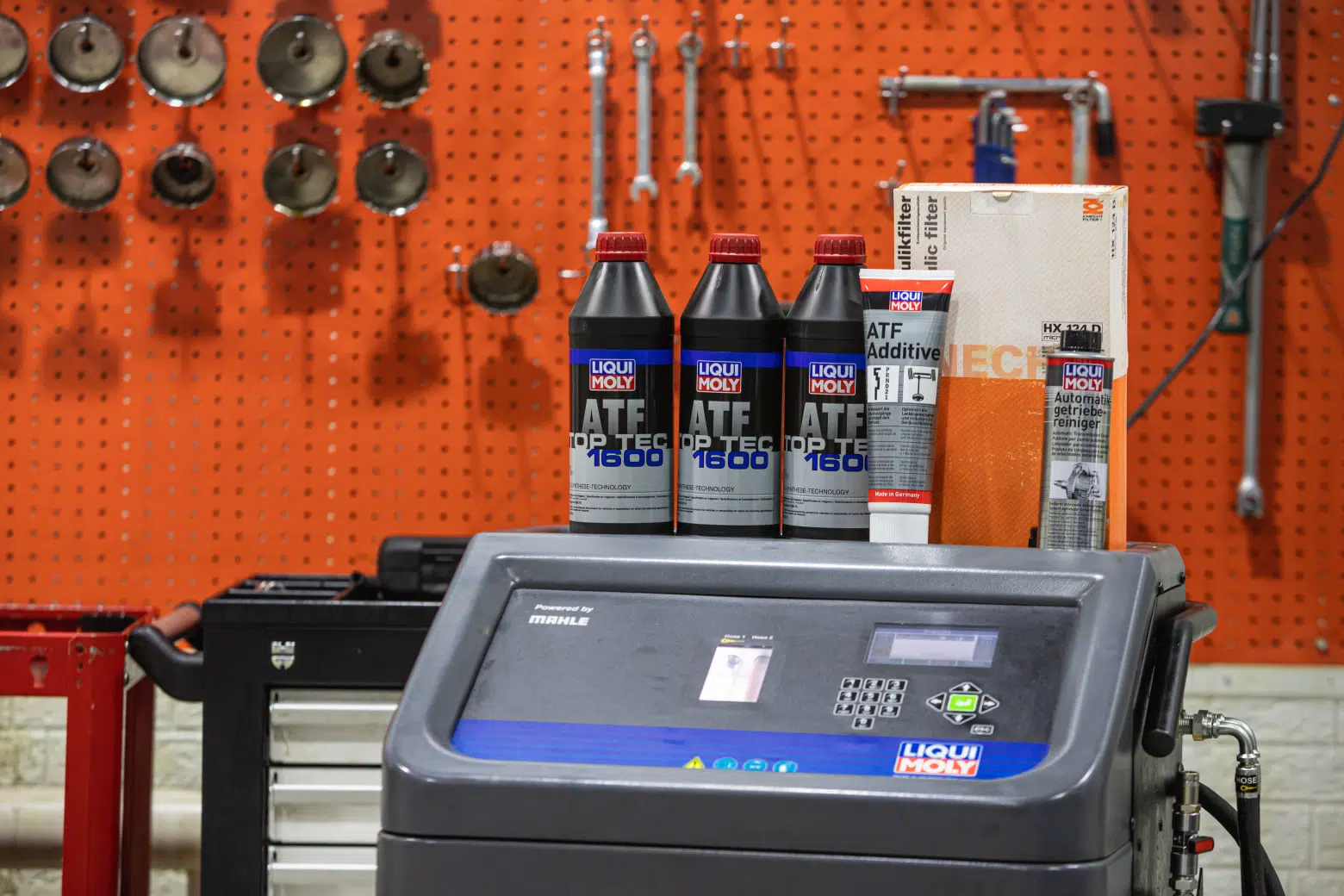
Automatic transmission oil filters play a vital role in maintaining clean and efficient transmission fluid by filtering out contaminants. It is essential to replace these filters every 30,000 to 50,000 miles or as specified by the manufacturer.
Using the correct type and size of oil filter, as recommended by your vehicle’s manufacturer, will ensure optimal performance and extend the life of your transmission.
The Cost of Automatic Transmission Fluid Replacement
The cost of automatic transmission fluid replacement can vary depending on whether you choose to do it yourself or seek professional service. Generally, DIY costs are lower than professional service costs, but both options have their advantages and disadvantages.
We will present a cost comparison of DIY and professional ATF replacement services to assist you in making an informed decision.
DIY Costs
If you decide to replace your ATF yourself, the typical cost ranges from £150-300 in the UK and $80-250 in the US, on average. These costs include the necessary tools and materials, such as a transmission fluid pump, funnel, drain pan, and new transmission fluid.
Although DIY ATF replacement can save you money, it requires more time and effort compared to professional service.
Professional Service Costs
The cost of professional service for ATF replacement can range from $80 to $400, depending on the vehicle model and the service provider. Factors that may influence the cost include the type of vehicle, the type of transmission fluid used, and the location of the service.
While professional service may be more expensive than DIY, it can save you time and effort, and ensure that the job is done correctly.
Summary
In conclusion, automatic transmission fluid plays a critical role in the performance and longevity of your vehicle’s transmission. By understanding the importance of ATF, selecting the right type for your vehicle, recognizing signs of transmission issues, and following proper maintenance tips, you can help ensure smooth and efficient operation. Whether you choose to replace your ATF yourself or seek professional assistance, regular maintenance is key to preventing costly repairs and extending the life of your transmission. So, take the time to care for your vehicle’s transmission, and it will surely serve you well for years to come.
Frequently Asked Questions
How do I know if my car needs automatic transmission fluid?
If you experience difficulty shifting, slipping gears, transmission leaks, burning smells, noisy operations, slow gear engagement, and/or poor acceleration, it is likely that your car needs automatic transmission fluid.
Do you need to change transmission fluid on automatic?
Yes, it’s important to change the transmission fluid on an automatic – usually every 30,000 to 60,000 miles.
What happens when automatic transmission fluid is low?
Low automatic transmission fluid can cause a noticeable delay when shifting gears, leading to sluggish response or even unresponsiveness when engaging Drive or Reverse.
It can also result in excessive friction, causing the system to overheat and emit an unpleasant burning smell.
Is gearbox fluid the same as transmission fluid?
No, gearbox fluid and transmission fluid are different; gear oil is generally intended for use in manual gear boxes, while transmission fluid is formulated to work with automatic transmissions.
Can you flush an automatic gearbox?
Flushing an automatic gearbox is recommended as the most effective way to change the fluid in the system. This is necessary due to the torque converter not draining, which results in much of the fluid staying in the system.
Regular servicing is also recommended in order to keep the fluid in optimal condition.
